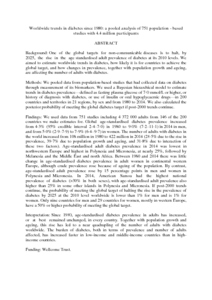Citation
Gyanchand Rampal, Lekhraj Rampal
(2016)
Worldwide trends in diabetes since 1980: a pooled analysis of 751 population - based studies with 4.4 million participants.
Lancet, 387 (10027).
pp. 1513-1530.
ISSN 0140-6736; ESSN: 1474-547X
Abstract
Background: One of the global targets for non-communicable diseases is to halt, by 2025, the rise in the age standardised adult prevalence of diabetes at its 2010 levels. We aimed to estimate worldwide trends in diabetes, how likely it is for countries to achieve the global target, and how changes in prevalence, together with population growth and ageing, are affecting the number of adults with diabetes.
Methods: We pooled data from population-based studies that had collected data on diabetes through measurement of its biomarkers. We used a Bayesian hierarchical model to estimate trends in diabetes prevalence—defined as fasting
plasma glucose of 7·0 mmol/L or higher, or history of diagnosis with diabetes, or use of insulin or oral hypoglycaemic drugs—in 200 countries and territories in 21 regions, by sex and from 1980 to 2014. We also calculated the posterior probability of meeting the global diabetes target if post-2000 trends continue.
Findings: We used data from 751 studies including 4 372 000 adults from 146 of the 200 countries we make estimates for. Global age-standardised diabetes prevalence increased from 4·3% (95% credible interval 2·4–7·0) in 1980 to 9·0% (7·2–11·1) in 2014 in men, and from 5·0% (2·9–7·9) to 7·9% (6·4–9·7) in women. The number of adults with diabetes in the world increased from 108 million in 1980 to 422 million in 2014 (28·5% due to the rise in prevalence, 39·7% due to population growth and ageing, and 31·8% due to interaction of these two factors). Age-standardised adult diabetes prevalence in 2014 was lowest in northwestern Europe, and highest in Polynesia and Micronesia, at nearly 25%, followed by Melanesia and the Middle East and north Africa. Between 1980 and 2014 there was little change in age-standardised diabetes prevalence in adult women in continental western Europe, although crude prevalence rose because of ageing of the population. By contrast, age-standardised adult prevalence rose by 15 percentage points in men and women in Polynesia and Micronesia. In 2014, American Samoa had the highest national prevalence of diabetes (>30% in both sexes), with age-standardised adult prevalence also higher than 25% in some other islands in Polynesia and Micronesia. If post-2000 trends continue, the probability of meeting the global target of halting the rise in the prevalence of diabetes by 2025 at the 2010 level worldwide is lower than 1% for men and is 1% for women. Only nine countries for men and 29 countries for women, mostly in western Europe, have a 50% or higher probability of meeting the global target.
Interpretation: Since 1980, age-standardised diabetes prevalence in adults has increased, or at best remained unchanged, in every country. Together with population growth and ageing, this rise has led to a near quadrupling of the number of adults with diabetes worldwide. The burden of diabetes, both in terms of prevalence and number of adults affected, has increased faster in low-income and middle-income countries than in high-income countries.
Funding: Wellcome Trust.
Download File
![[img]](http://psasir.upm.edu.my/53262/1.hassmallThumbnailVersion/Worldwide%20trends%20in%20diabetes%20since%201980%20a%20pooled%20analysis%20of%20751%20population%20-%20based%20studies%20with%204.4%20million%20participants.pdf)  Preview |
|
PDF
Worldwide trends in diabetes since 1980 a pooled analysis of 751 population - based studies with 4.4 million participants.pdf
Download (109kB)
| Preview
|
|
Additional Metadata
Actions (login required)
 |
View Item |

